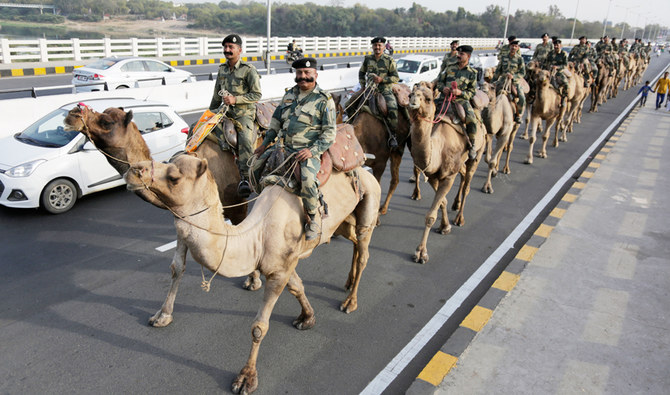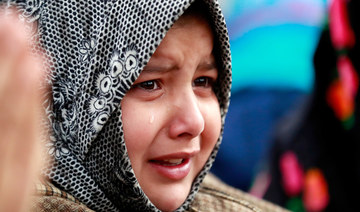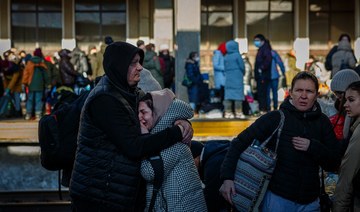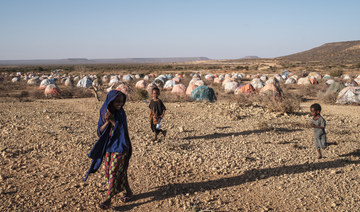NEW DELHI: A gala welcome awaits US President Donald Trump, who will begin his first official visit to India on Monday after landing in the western Indian city of Ahmedabad.
More than 150,000 people are expected to attend the “Namaste Trump” event at a newly built cricket stadium on the outskirts of the city where both the US leader and Prime Minister Narendra Modi are expected to address a huge gathering.
Later, the US president and his family — wife Melania, daughter Ivanka and son-in-law Jared Kushner — will watch the sun set at the iconic Taj Mahal in Agra.
However, the optics of Trump’s high-octane visit are not enough to hide underlying tensions brewing between the two countries, particularly on the trade front and on New Delhi’s decision to go ahead with its contentious Citizenship Amendment Act (CAA).
For the past two months, India has faced unprecedented criticism over the CAA, which grants citizenship to minorities from neighboring Bangladesh, Afghanistan and Pakistan, but excludes Muslims.
A White House statement shared by the US Embassy in New Delhi on Saturday said that Trump would raise the “religious freedom issue” in the bilateral meeting between the two heads of state.
“The world is looking to India to continue to uphold its democratic traditions, respect for religious minorities,” the statement added.
Muslims fear that the CAA and the proposed National Register of Citizens (NRC) will leave many in the minority community stateless.
“The US should exercise its influence and ask the Indian leadership to withdraw the contentious citizenship legislation. I hope Trump uses his good office to persuade Modi to roll back his majoritarian agenda,” Ovais Sultan Khan, a New Delhi civil rights activist, told Arab News on Saturday.
India’s Foreign Ministry has refused to comment on the matter, saying that Trump’s visit reflects “the renewed and growing intensity of high-level engagements between the two countries.”
The White House statement also said that Trump would “encourage” India and Pakistan “to engage in bilateral dialogue with each other to resolve their differences.”
However, trade issues remain a sticking point between the US and India with Washington seeking a reduction in Indian tariffs to boost business.
India is calling for a restoration of the Generalized System of Preferences (GSP), a preferential tariff system extended by developed countries to developing countries. Last year, Trump revoked the GSP and imposed a high import duty on all goods from India.
HIGHLIGHT
The White House statement said Trump would ‘encourage’ India and Pakistan ‘to engage in bilateral dialogue with each other to resolve their differences.’
Trade in goods and services between the two countries makes up 3 percent of the US total worldwide.
In 2018, the US was India’s second-largest export market (16 percent) after the EU (17.8 percent), and third-largest import supplier (6.3 percent) after China (14.6 percent) and the EU 28 (10.2 percent).
According to the Washington-based Council on Foreign Relations, India’s trade with the US now resembles “in terms of volume, US trade with South Korea ($167 billion in 2018) or France ($129 billion).”
“The concerns that led to the revocation, suspension of India’s GSP access remain a concern for us. We continue to talk to our Indian colleagues about addressing these market access barriers,” the White House statement said.
Experts believe that the US leader lacks the credibility to dictate conditions to India.
“Trump is not in a strong position to raise the issue of religious freedom in India considering his own record in the US. I think a large part of talks between Trump and Modi will be on Afghanistan due to the immediacy of the peace deal between the Taliban and the US,” Prof. Harsh V. Pant, of the New Delhi-based think Observer Research Foundation, told Arab News.
After years of fighting, and 18 months of talks to resolve the conflict in Afghanistan, the Taliban and the US agreed to sign the peace deal on Feb. 29.
However, despite the challenges on trade and other issues, there is a degree of mutual understanding between the two nations, Pant said.
“American presidential visits are all about optics. What is important is that Trump is coming to India in an election year. The India-US relationship has moved beyond the transnationalism that many think Trump embodies,” he said.
























